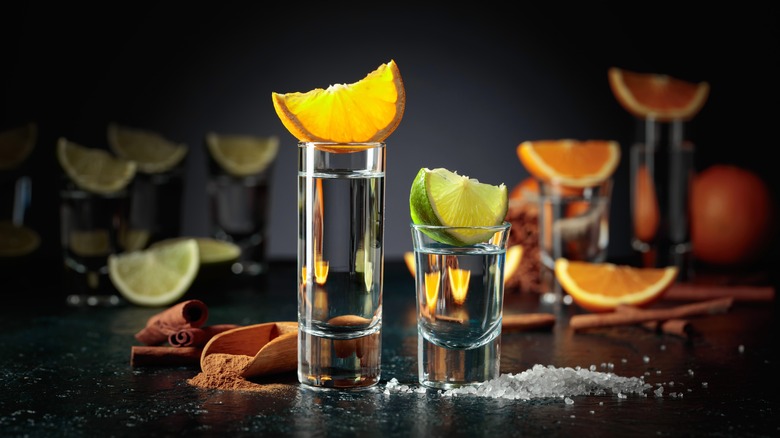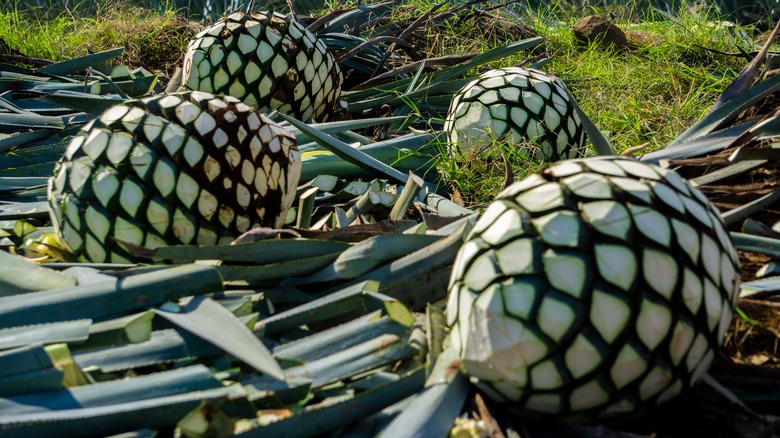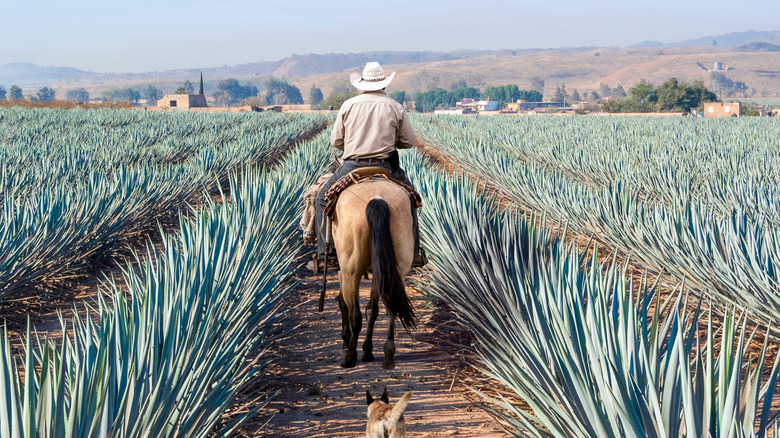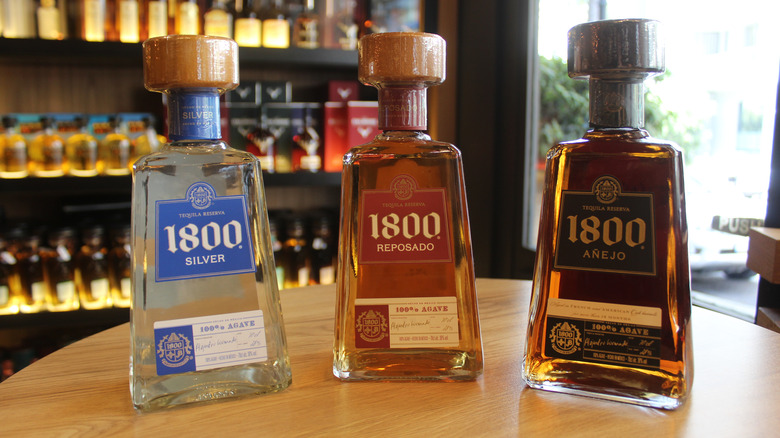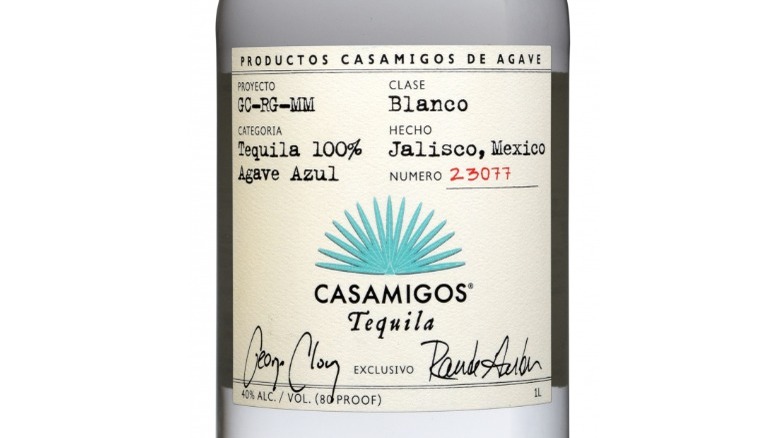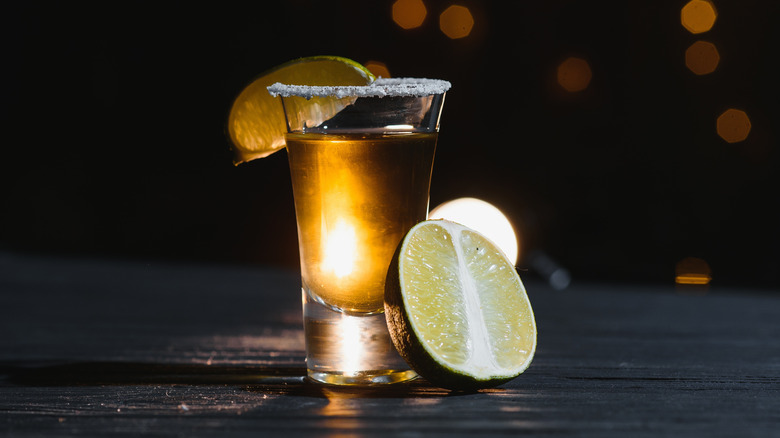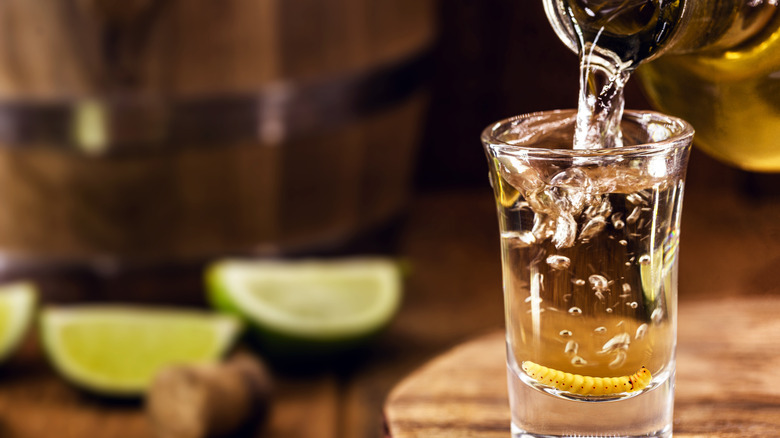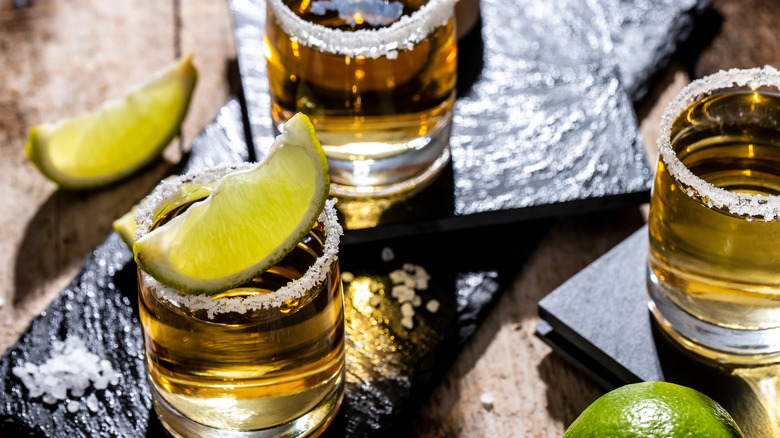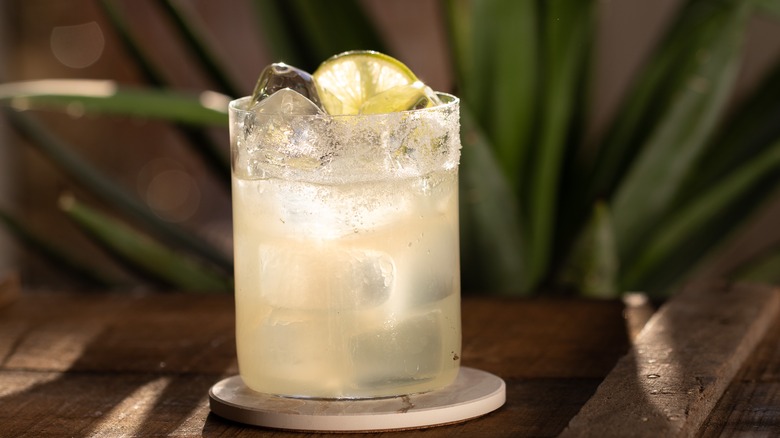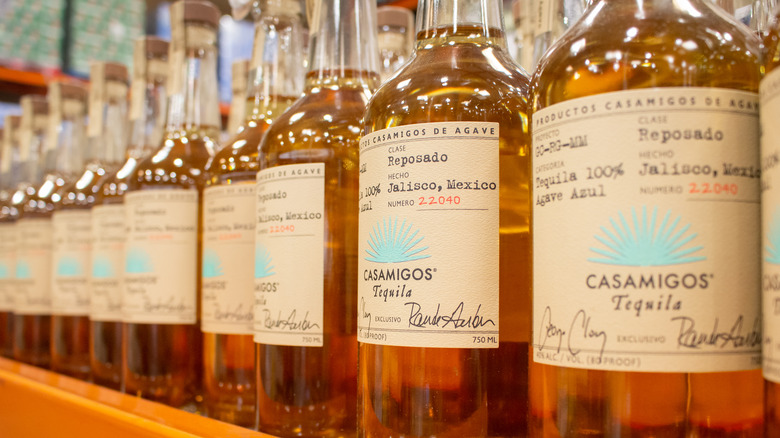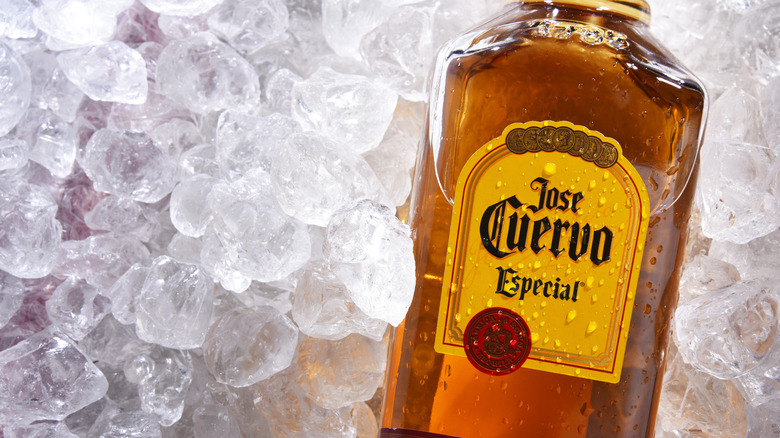A Beginner's Guide To Tequila
There are plenty of reasons someone might want to expand their palate to include tequila. Not only is the liquor a key ingredient in many beloved cocktails, but it also makes for enjoyable sipping on its own.
Tequila is a distilled liquor made from the juice of agave, which is a succulent. Fermented agave drinks go back thousands of years, first made by the Aztecs around 250-300 AD. At the time, agave juice was typically fermented into agave wine; it wasn't until the 1600s that wine was transformed through distillation into the liquor known today as tequila. In the centuries to come, the drink would spread across the globe and into the shot glasses of incalculable elbow-tippers.
Separating itself from comparable liquors, tequila has some unique characteristics and uses. Below, everything you need to order tequila with confidence, from the origins of the drink, to how it gets to your glass, to the best ways to drink it.
How it is made
Tequila production begins with the blue agave plant. Seen in its full form, the plant stands out with long, spiky, blue-green leaves that protrude from the fruit at the center of the plant. While the plant starts small, at its full maturity the leaves can reach about eight feet long, with a final plant height of 10 feet. To make many tequilas, fully mature plants must be employed, and it takes about eight years for agave to reach full maturity, so it can be a lengthy process.
Once the plant reaches full maturity, it is time to harvest. First, the long leaves are stripped away, revealing the heart of the plant. This is called the "piña" because it looks like a pineapple. Next, the juices are extracted from the piña. This involves cooking and cooling the heart before it is crushed to fully extract the juices. The juice is then mixed with yeast and fermented, yielding s a sort of agave wine or beer. Finally, the agave wine goes through the distillation process, raising the alcohol content and refining it into tequila. The end result can either be bottled immediately for sale or aged before bottling.
Unlike many other liquors — such as your typical whiskey and vodka — no grains are used to make tequila; as a result, it is 100% gluten-free.
Where tequila is made
It's hard to think of tequila and not also think of Mexico. There is a reason for that. Much like how champagne must come from the Champagne region in France, Tequila must come from Mexico; otherwise, it is just an agave spirit.
The first significant tequila distillery was founded in the 1600s, in what is now known as the town of Tequila. The drink continued to grow in popularity, with distillery growth commensurate. In the 1970s, the Mexican government took steps to protect the name, making it illegal to produce tequila outside of the country. Today, tequila is only produced in Michoacán, Guanajuato, Nayarit, Tamaulipas, and Jalisco.
If you want to verify the validity of your tequila, there are two things you can do. If the bottle says "product of Mexico," it's legitimate; if the bottle carries a "NOM" (Normal Oficial Mexicana) symbol followed by a set of numbers, that also makes it an official tequila. This is because every official tequila distillery has a registered NOM with the Mexican Government, certifying it is an actual tequila distillery. The Mexican government takes tequila seriously; if there is no NOM, it is not tequila.
Types of tequila
Tequila falls into two categories: 100% agave tequila and mixto tequila.
While100% agave tequila is made from only agave, mixto is tequila made with 51% agave and cut with added sugar,; this can often include corn syrup, as well as colors, flavors, and other additives. Tequilas are then separated into five categories based on their age.
The youngest is blanco, also known as "silver" tequila; it is clear, hence the moniker. Blanco tequila is functionally not aged. It is bottled within two months of production.
Next is joven, or "young" tequila. It is made from a mixture of aged and un-aged tequila. It is not as deeply colored as older tequilas, but also not clear like blanco. It falls somewhere in the middle.
Resposado is where the tequila categories begin being aged. The name means "rested," and the tequila is left to age in oak barrels for two months to a full year. The result is a deeper brown color and a more complex flavor, thanks to the barrel-aged process.
Then there is añejo, which means "old." Aged between one and three years, it is just less than the final category: extra añejo, or "extra old." Extra añejo tequila has been aged for more than three years. The newest of the categories, extra añejo was added in 2006.
Reading the tequila label
Once you have the tequila categories in mind, head to your local store and store. Inspecting any bottle of tequila, you'll see that the label will have a lot of information; at first, it can be overwhelming. But with a bit of deciphering, it can help you pick the best bottle for your needs.
Make sure the bottle says "tequila" and not "agave spirit," or some other variation such as mezcal; also be sure to look for some variation on "made in Mexico" or "producto de Mexico" or "elaborando en Mexico." Once you have determined it is tequila, the label will also tell you if it is 100% agave. If you don't see those words, you're looking at mixto. Then you should look for the tequila's category, typically listed on the label. Some (such as blanco) are easy to identify based on color, but the aged ones can be difficult to tell apart unless you read the label.
The brand name will also be displayed prominently. Typically, the distillery name and address, if not on the front label, will be on the back, along with the NOM symbol. Somewhere around the size of the bottle (typically listed in milliliters), the alcohol content should be listed; typically, it will be between 38% and 50%.
Finally, the lot or batch number will be listed, in compliance with regulations. Additional information, such as the bottle number or batch size, may be listed, but it is not required.
Flavor and characteristics
The way tequila is processed can make a huge difference in its flavor and characteristics. For example, one common claim is that mixto tequila is more likely to give you a hangover. Additionally, while color can be an indication of age, some mixto tequila will add a gold color to young tequila, giving the false appearance it has been aged longer.
Young tequila is not bad, though. Tequila blanco, as the youngest tequila, has the least amount of natural color and additional flavors. Notably, it offers notes of agave and citrus. It has the purest, lightly earthy flavor of them all. It is often a good choice for cocktails such as margaritas.
As more aging is introduced to the mix, notes from oak barrels come through. This means amber color and flavors such as spices and dried fruit are infused into the mix. Additionally, tequila becomes smoother, with less of a cutting bite, as it ages. Tequila, in general, also offers a sweeter flavor, especially when compared to other liquors, such as vodka and whiskey. It also has a more distinct flavor, particularly when compared to vodka.
Price range
There is a huge range in the prices of tequila, with bottles costing as little as $15 or as much as several hundred. There are multiple factors that can play into the price, including differences in quality and processing. For example, the longer a tequila is aged, the more expensive it is likely to become. Additionally, 100% agave tequila is almost always costlier than a mixto tequila.
The processing has a significant impact on flavor. Steam ovens employed to cook the agave hearts take longer than other methods, such as quick-cooking autoclaves. The longer process can make a better tequila but at a price.
But you can't just judge a tequila by its price. As with any industry, some companies will charge more based on their reputation alone, or add food coloring to appear to be aged and therefore worth a higher price. Don't fall for these tactics; an educated tequila buyer examines the label, determining if the drink is worth the investment.
Tequila vs mezcal
Many folks are confused about the difference between tequila and mezcal. While both are agave spirits made in Mexico, mezcal is a far broader term.
It is commonly said that all tequilas are mezcal; which is frequently made in the Oaxaca region, though it can be made in other areas including Durango, Guanajuato, Guerrero, Michocán, Puebla, San Luís Potosí, Tamaulipas, and Zacatecas.
Tequila must be made from blue agave, whereas mezcal can be made from other agave varieties. People who have tried the two drinks may notice that mezcal tends to be smokier in flavor. This is because where tequila traditionally uses steamed agave, mezcal often uses wood-fired agave. There are also more flavor variations in mezcal than in tequila.
The ability to use different types of agave and to be made in different regions with varying terroir can give mezcal a wider variation in taste, pungency, and nuance to the than tequila. And like tequila, mezcal has its own categories and regulation committees. Mezcal production is overseen by the Consejo Regulador del Mezcal, which categorizes mezcal as mezcal, artesanal, or ancestral, depending on its production method.
There is no tequila worm
There has been a long-standing belief that tequila comes with a worm at the bottom of every bottle, like the meat hunk in a can of beans. But this is not true.
This likely began in the 1940s in America, when student-turned-entrepreneur Jacobo Lozano Paez wanted a way to add a unique flavor to his mezcal. He decided to add a gusano de maguey to the bottle — technically a moth larva, not a worm. While the larva has been eaten in Mexico since the Aztecs, it is traditionally added to one specific kind of mezcal — not all mezcal, and not tequila.
As years passed, adding the larva became a marketing ploy, particularly in America. But it was added to mezcal, not tequila, and was meant to help consumers differentiate between the two; ironically, it only seems to have added to their conflation.
Also worth noting is that, according to NOM standards, no insects (including larvae) can be added to a tequila bottle. So, if somebody dares you to eat the worm, at least now you'll know what you're drinking.
How to serve tequila
How you enjoy your tequila is entirely up to you. However, there are some general guidelines that can be helpful.
Tequila is not just for mixing and pouring shots; quality tequila is perfect for sipping. This is especially true for aged tequila, such as añejo and extra añejo, as they will be the smoothest and have the most robust flavor. Sipping tequila should be served at room temperature, but it can also be served with ice.
Blanco tequila is often a good choice for cocktails, as it has the cleanest, lightest flavor. It will be good for margaritas or Palomas. For those looking for a bit of a bolder flavor in their cocktails, joven and reposado make excellent choices as well.
This does not mean you can't put higher quality or older tequila in a cocktail or shot. But it isn't necessary to pay for high-shelf tequila when low-shelf will do just fine — and sometimes, even better.
Popular tequila cocktails
If you would prefer to drink your tequila in a cocktail rather than straight, there are tons of popular tequila cocktails out there. The classic is, of course, the margarita, which some studies show is the most popular cocktail in the United States.
Traditionally made from tequila, lime juice, and orange liquor, the margarita has evolved substantially over the years; modern variations on the drink include countless flavor varieties, often in the form of bottled margarita mixers widely available to make your cocktail preparation easier.
Citrus is a popular pairing with tequila. The paloma, a cocktail made from tequila and citrus, features grapefruit soda and often includes lime juice and additional sugar. The tequila sunrise features tequila, orange juice, and grenadine layered in the glass. Ranch water features tequila, lime juice, and seltzer water mixed to make a light and refreshing cocktail.
Tequila can also play a part in riffing off some of your other favorite cocktails. By swapping whiskey for tequila, you can make a tequila old-fashioned. Or swap vodka for tequila and turn a Moscow mule into a Mexican mule.
A lot of celebrities own tequila
An unexpected but intriguing phenomenon of the past few years has been celebrities putting their names on tequila brands. Michael Jordan, for example, partnered with other NBA owners to create Cincoro, a luxury tequila brand that launched in 2019. Jordan worked with designer Mark Smith, who worked on designs for Air Jordans, to create the unique bottle design.
The Kardashian-Jenner family, of course, has their own tequila; in 2021, Kendall Jenner launched 818 Tequila. Dwayne "The Rock" Johnson and Dany Garcia launched Teremana Tequila in 2020.
Actor George Clooney hopped on the celebrity tequila train early as a co-founder of Casamigos, which launched in 2013. Nick Jonas, of the Jonas brothers, Eva Longoria, Adam Levine, and Mark Wahlberg have also joined in via various tequilas, many of which you can find them frequently advertising on their social media.
Popular tequila brands
There are also, of course, popular non-celebrity brands of tequila. According to The Spirits Business, Jose Cuervo is the most popular, based on volume. They are the biggest by far, with more than double the next most popular brand, Patrón.
This is not surprising, as the Cuervo family has long claimed to be the first tequila producers, going back all the way to 1758. The brand makes a wide range of products — including mixto — such as Especial Silver and Gold, as well as 100% agave tequila, such as Tradicional Añejo and Tradicional Cristalino, which is a reposado tequila.
The second most popular, Patrón, does not make mixto. Instead, it is marketed as a super premium tequila, all of which is 100% agave. Casamigos saw the most significant jump in sales between 2020 and 2021, nearly doubling their sales numbers in just a year. Their tequila is also 100% agave, and costs about the same as Patrón. Other readily available brands, such as Milagro and El Jimador, are also made with 100% agave and come in at a fraction of the price.
